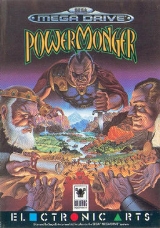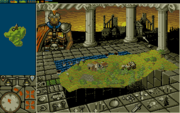
Powermonger
Encyclopedia
Powermonger is a real-time strategy
game developed by Bullfrog
in 1990
, derived from the Populous
engine but presented using a 3-dimensional
game map. It won Computer Gaming World
s 1991 Strategy Game of the Year award.
game map, although camera movement is limited to rotating the map by 90 degrees or small discrete intervals and 8 pre-defined levels of zoom. Only the map topography
itself is 3-dimensional; people, trees and other game objects are 2-dimensional
sprites
.
The game also features a fairly advanced (for its time) "artificial life" engine. Each person seems to have a mind of their own and will go about his or her job, fishing, farming, shepherding, collecting wood or making items without any input from the player. You also have a query tool that can be used to see the name, sex, age, allegiance, vital stats, hometown and equipment for any given person you click on. This aspect of the game has some clear resemblances (though less advanced) with the more recent Black & White game also designed by Peter Molyneux
.
While the player cannot form the land like in Populous
, actions can still have some limited effect on the environment. For example if a large area is deforested, the weather pattern will change and more rain or snow (depending on season) will fall, making movement slower.
 The player starts out on each map with a small number of soldiers, and maybe a few towns already under control. To win the map, the balance of power needs to be tipped completely to the player's side (represented by a scale below the mini-map), by conquering all (or at least most) of the towns on the map, and killing any opposing captains. Once a town is under the player's control, locals can be drafted into the player's army and bigger towns or enemy armies can be taken on. Some of the bigger towns also have neutral captains and if these survive the battle they come under the player's command as well.
The player starts out on each map with a small number of soldiers, and maybe a few towns already under control. To win the map, the balance of power needs to be tipped completely to the player's side (represented by a scale below the mini-map), by conquering all (or at least most) of the towns on the map, and killing any opposing captains. Once a town is under the player's control, locals can be drafted into the player's army and bigger towns or enemy armies can be taken on. Some of the bigger towns also have neutral captains and if these survive the battle they come under the player's command as well.
The player can only control as many armies as captains, so it is important to keep them alive. If a captain is killed, his army is disbanded and his surviving soldiers go back to their town of origin. Unlike the player's main army - which the main character commands - the subordinate captains have a "lag" time (indicated by a tiny homing pigeon
animation next to their command icon) before their commands are executed. The further away from the player's main character they are, the longer it takes for orders to reach them.
Food is the single most important resource in the game. Aside from friendly towns the player can also slaughter wandering sheep, barter food from neutral towns, or kill an enemy captain and pillage his food supply.
Aside from manpower and food towns can also provide equipment. Townspeople will occasionally make items, but to speed things up the player can order an army to "invent" at a friendly town. Depending on nearby resources and what posture the army is set to (passive, neutral or aggressive), men will then go to work collecting resources and make items. As the more useful items can usually only be made in one or two towns on any given map these have great strategic importance.
There is no micro management involved with equipment. Once an army is ordered to equip itself from a pile of equipment it is automatically distributed. If there are bows, swords and pikes available, soldiers will pick them up in that order. As long as there are soldiers without any weapon in the army no one will pick up more than one weapon. If everyone has something then people with the least valuable weapon will have first pick and so on. The captain carries any excess equipment. There is no limit to how much a captain can carry, but the more he carries the slower he (and his army) will move.
an expansion disk (for computers only) was released that changed the setting from the conquest of a medieval kingdom, to World War I
. The game play was still essentially the same, but with more ranged weapons and war-machines.
#168 by Hartley, Patricia, and Kirk Lesser in "The Role of Computers" column. The reviewers gave the game 5 out of 5 stars.
Real-time strategy
Real-time strategy is a sub-genre of strategy video game which does not progress incrementally in turns. Brett Sperry is credited with coining the term to market Dune II....
game developed by Bullfrog
Bullfrog Productions
Bullfrog Productions was a UK computer game developer that was founded in 1987 by Les Edgar and Peter Molyneux. The company achieved recognition in 1989 for their third release, Populous....
in 1990
1990 in video gaming
-Notable releases:*Bonk's Adventure is released for NEC's TurboGrafx-16 and is the first US appearance of Bonk, the mascot of the TurboGrafx-16.*February 12 — Nintendo releases the NES game Super Mario Bros. 3 in North America...
, derived from the Populous
Populous
-External links:*...
engine but presented using a 3-dimensional
3D computer graphics
3D computer graphics are graphics that use a three-dimensional representation of geometric data that is stored in the computer for the purposes of performing calculations and rendering 2D images...
game map. It won Computer Gaming World
Computer Gaming World
Computer Gaming World was a computer game magazine founded in 1981 by Russell Sipe as a bimonthly publication. Early issues were typically 40-50 pages in length, written in a newsletter style, including submissions by game designers such as Joel Billings , Dan Bunten , and Chris Crawford...
s 1991 Strategy Game of the Year award.
Background
The game features a 3-dimensional3D computer graphics
3D computer graphics are graphics that use a three-dimensional representation of geometric data that is stored in the computer for the purposes of performing calculations and rendering 2D images...
game map, although camera movement is limited to rotating the map by 90 degrees or small discrete intervals and 8 pre-defined levels of zoom. Only the map topography
Topography
Topography is the study of Earth's surface shape and features or those ofplanets, moons, and asteroids...
itself is 3-dimensional; people, trees and other game objects are 2-dimensional
2D computer graphics
2D computer graphics is the computer-based generation of digital images—mostly from two-dimensional models and by techniques specific to them...
sprites
Sprite (computer graphics)
In computer graphics, a sprite is a two-dimensional image or animation that is integrated into a larger scene...
.
The game also features a fairly advanced (for its time) "artificial life" engine. Each person seems to have a mind of their own and will go about his or her job, fishing, farming, shepherding, collecting wood or making items without any input from the player. You also have a query tool that can be used to see the name, sex, age, allegiance, vital stats, hometown and equipment for any given person you click on. This aspect of the game has some clear resemblances (though less advanced) with the more recent Black & White game also designed by Peter Molyneux
Peter Molyneux
Peter Douglas Molyneux OBE is an English computer game designer and game programmer. He created the God games Dungeon Keeper, Populous, and Black & White, among others, as well as business simulation games such as Theme Park and more recently, the RPG series Fable.Despite the success of his games,...
.
While the player cannot form the land like in Populous
Populous
-External links:*...
, actions can still have some limited effect on the environment. For example if a large area is deforested, the weather pattern will change and more rain or snow (depending on season) will fall, making movement slower.
Gameplay

The player can only control as many armies as captains, so it is important to keep them alive. If a captain is killed, his army is disbanded and his surviving soldiers go back to their town of origin. Unlike the player's main army - which the main character commands - the subordinate captains have a "lag" time (indicated by a tiny homing pigeon
Homing pigeon
The homing pigeon is a variety of domestic pigeon derived from the Rock Pigeon selectively bred to find its way home over extremely long distances. The wild rock pigeon has an innate homing ability, meaning that it will generally return to its own nest and its own mate...
animation next to their command icon) before their commands are executed. The further away from the player's main character they are, the longer it takes for orders to reach them.
Food is the single most important resource in the game. Aside from friendly towns the player can also slaughter wandering sheep, barter food from neutral towns, or kill an enemy captain and pillage his food supply.
Aside from manpower and food towns can also provide equipment. Townspeople will occasionally make items, but to speed things up the player can order an army to "invent" at a friendly town. Depending on nearby resources and what posture the army is set to (passive, neutral or aggressive), men will then go to work collecting resources and make items. As the more useful items can usually only be made in one or two towns on any given map these have great strategic importance.
There is no micro management involved with equipment. Once an army is ordered to equip itself from a pile of equipment it is automatically distributed. If there are bows, swords and pikes available, soldiers will pick them up in that order. As long as there are soldiers without any weapon in the army no one will pick up more than one weapon. If everyone has something then people with the least valuable weapon will have first pick and so on. The captain carries any excess equipment. There is no limit to how much a captain can carry, but the more he carries the slower he (and his army) will move.
Expansion
In 19911991 in video gaming
-Notable releases:*Microprose creates Civilization, Sid Meier's most successful game .*Electronic Arts releases James Pond 2 and Road Rash for Sega Genesis/Mega Drive, starting a series of games that were popular in the 1990s....
an expansion disk (for computers only) was released that changed the setting from the conquest of a medieval kingdom, to World War I
World War I
World War I , which was predominantly called the World War or the Great War from its occurrence until 1939, and the First World War or World War I thereafter, was a major war centred in Europe that began on 28 July 1914 and lasted until 11 November 1918...
. The game play was still essentially the same, but with more ranged weapons and war-machines.
Reception
The game was reviewed in 1991 in DragonDragon (magazine)
Dragon is one of the two official magazines for source material for the Dungeons & Dragons role-playing game and associated products, the other being Dungeon. TSR, Inc. originally launched the monthly printed magazine in 1976 to succeed the company's earlier publication, The Strategic Review. The...
#168 by Hartley, Patricia, and Kirk Lesser in "The Role of Computers" column. The reviewers gave the game 5 out of 5 stars.

